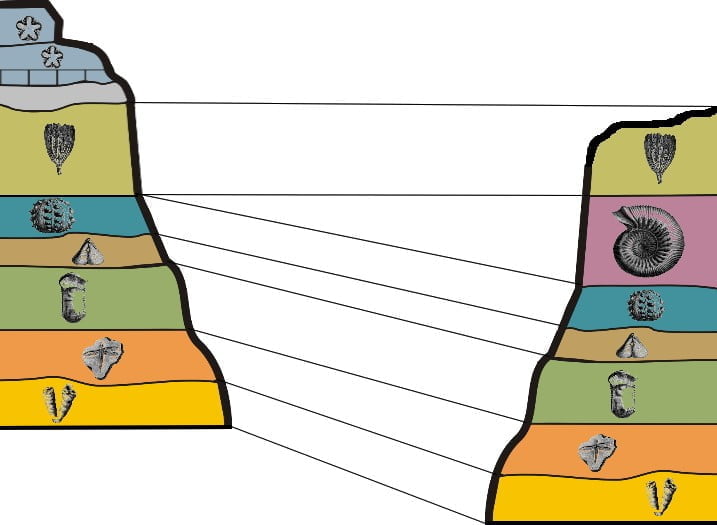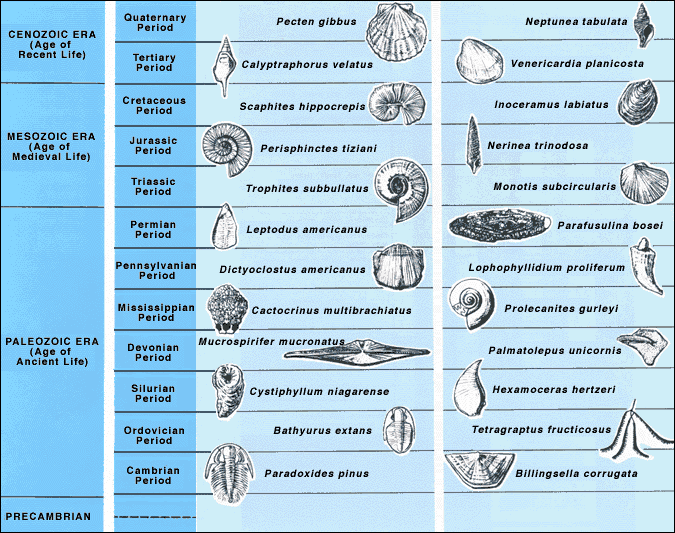When reading about paleontology or fossils, you are sure to stumble across the words ‘index fossil’ at some point. But what is an index fossil, and why do we have them?
Why are some fossils given this title but not others? There are a few factors that decide whether a fossil can be used as an index fossil or not. What are index fossils?
An index fossil is any fossil that is used as a representative for a specific span of geologic time. These can be animals, plants, or ichnofossils. Index fossils must be distinct and recognizable, occur only in a short period of time, and spread across a wide geographic area.
Here, we’ll discuss how index fossils are defined and what makes them so important to paleontology and science in general. Keep reading.
What Makes an Index Fossil?
There are very few terrestrial index fossils; almost all of them are marine animals such as conodonts, graptolites, or ammonoids.
To be an index fossil, a fossil must:
- Be distinct and recognizable
- Only occur in a short period of time
- Be spread across a wide geographic area
It is also good if the fossil has rapid forms of evolution. This makes for good index fossils because there will only be a short time that a specific form exists, like in ammonites and their relatives.
A similar term you may come across is a ‘zone’ fossil. This is a fossil that has all of the characteristics of an index fossil except being widespread. These fossils are still useful for determining different time zones on a local basis.
Index fossils are an important part of biostratigraphy. This method uses fossils that lived during certain times to create zones for the rocks where these fossils can be found.
Biostratigraphy is still relatively new to science, but the idea of layers of animal and plant remains that lived during different periods has been around for a long time.
The ‘principle of faunal succession’ was a rule defined by English geologist William Smith in the early 1800s. It explains that fossils occur in layers that stack on top of each other.
You can learn more about these principles in our article that covers why fossils are found in sedimentary rock.

This means that millions of years old fossils will never be found alongside thousands of years old fossils. Because of that, rock layers can be organized into age groups by the fossils found inside of them.
How Does an Index Fossil Work?
Let’s take a look at a real-world example. A sample of limestone from Uuga Cliff in Estonia contains several fossil teeth of conodonts. These eel-like animals lived from the Cambrian to the Carboniferous and were found all over the globe.
The conodont species found in this specific section include Venoistodus balticus, Semiacontiodus cornuformis, Oslodus semisymmetricus, Panderodus sulcatus, and the index fossil species Pygodus serra. When looked at one by one, these species occurred between 485.4 million to 419.2 million years ago.

This is a range of 66.2 million years! However, we can use the index fossil Pygodus serra to date this rock unit. This changes it to a range of only 2.1 million years between 463.5 million to 460.9 million years ago.
Why are Index Fossils Important?
Many parts of the geologic time scale have been defined by the first appearance datum (FAD) of index fossils. Biostratigraphy is usually relative, meaning that zones can sometimes only be described as ‘older’ or ‘younger’ than each other.
We also have lots of index fossils that are found in layers that can be dated using other methods. Let’s use the Ordovician period as an example.
It is officially defined by the FAD of a species of conodont, Iapetognathus fluctivagus, but we don’t know how long ago that happened based on the fossil alone. We know that it was 485 million years ago because of radioactive dating.
Check out this PDF available at researchgate.net to learn more about conodonts. The full text was originally published in the Estonian Journal of Earth Sciences.
Even though index fossils can define the boundaries of time zones they are not always used for this purpose.
The Oktavites (Monograptus) spiralis zone of western Canada is based on a fossil species of graptolite. These are small filter-feeding creatures.
For more on graptolites, here is a PDF provided by the U.S. Geological Survey.
This species lived in the late Llanderovy into the early Wenlock epochs in the Silurian period. The boundary between these epochs is placed around 433 million years ago, but the fossils of this species can be found anywhere between 443 to 419 million years ago.
If a rock is found in this biozone it can be called Silurian in age. Unless there are other ways to decide, however, it could belong to either the Llanderovy or Wenlock epochs.
In the same way, two Silurian deposits that have no available methods to narrow down the age can still be called older or younger than each other. If one is in this same Oktavites (Monograptus) spiralis biozone, something in the Lituigraptus (Monograptus) convolutus biozone is older even if we don’t know the exact years.
We now know that index fossils are an important tool for figuring out how old a deposit is. What if we have a fossil deposit without any index fossils present?
This is a common problem with terrestrial fossil deposits. This is because terrestrial species usually live in small geographical ranges. We can still usually narrow down the time range at least a little by looking at the overall faunal assemblage.
‘Faunal assemblages’ are groups of animals that are found together, either in one deposit or in one span of time. These can help narrow down more accurate dates. The amount of time that each species existed usually overlaps with each other in a smaller time span.

Index fossils are more useful than this because of the confidence we have about their ages. We can be certain about their ages because they are abundant in the fossil record.
This means that it is unlikely that new discoveries will alter these ranges, though this happens from time to time. Paleontology is ever-changing!
What are Index Fossils Able to Reveal About the Past?
In another article that covered the misconception that plastic dinosaurs are made from real dinosaurs, we covered how index fossils can be used to find oil. This is certainly a very big industry that employs geoscientists. This could be another interesting job opportunity like those mentioned in our article on paleontology careers.
Index fossils can help scientists quickly identify the relative age of fossils so that they can better understand the types of fossils likely to be present in a given range. They also can play a vital role in identifying what past environments were like and which lifeforms inhabited various biomes.
If you thought this article was interesting, leave us a comment telling us what topics to cover next. As always, sharing our content is the best way to help us grow our following.

